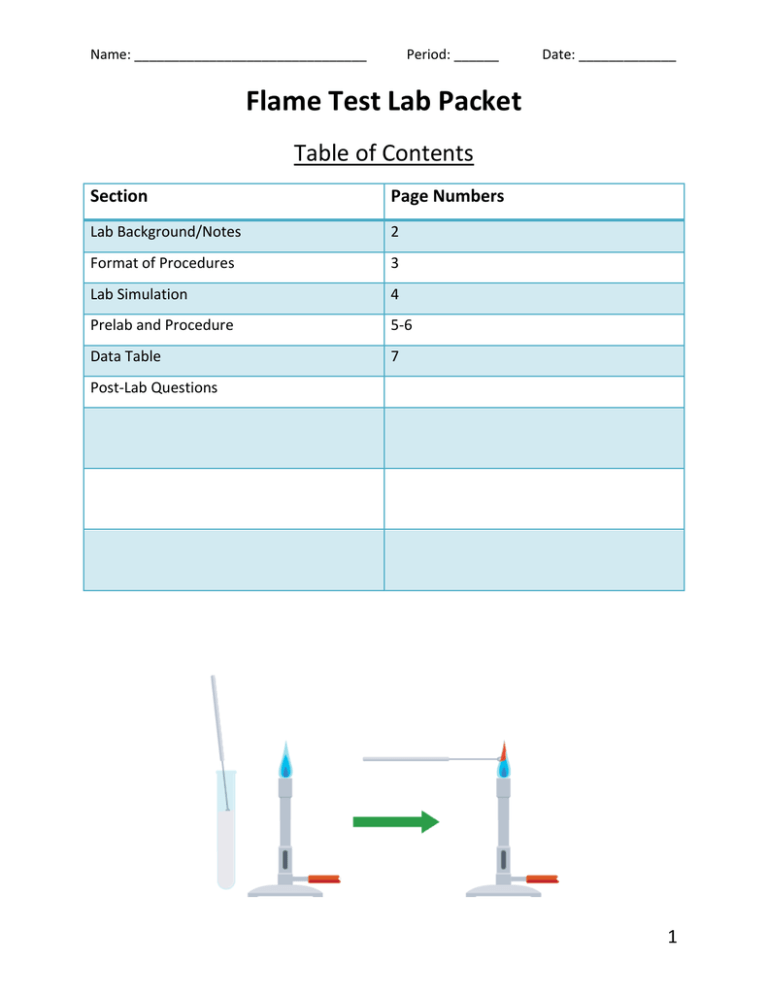flame test lab simulation
advertisement

Name: _______________________________ Period: ______ Date: _____________ Flame Test Lab Packet Table of Contents Section Page Numbers Lab Background/Notes 2 Format of Procedures 3 Lab Simulation 4 Prelab and Procedure 5-6 Data Table 7 Post-Lab Questions 1 Flame Test Lab Background BOHR’S THEORY Electrons exist in energy levels Energy levels are structured like fixed orbits around the nucleus ELECTRONS’ EXCITING JOURNEYS: 1. 2. 3. 4. 5. KEY POINT: _________________________________________________ __________________________________________________________ 2 LAB REPORT PROCEDURES Excerpt from Ms. Eggleston’s published research paper: “Rats in the exercise groups were provided with 24-hour access to a running wheel for 3 weeks prior to the start of the behavioral procedures and continued to have access to the wheels throughout the entire study. The door to the wheel was blocked off two hours prior to behavioral training in order to minimize the potential for exercise-related fatigue. The number of wheel rotations was recorded daily.” Requirements of Lab Report Procedures Practice Turning Directions Into Correctly Formatted Lab Report Sentences Directions Correct Format for Lab Reports Put the cat in the bag and pet it for 3 minutes. Pick Madelaine up and spin her around 2 times. Put on your goggles, tie your hair back, and remove loose clothing. Using tweezers, pick up a toothpick that has been soaked in a solution. Place the toothpick in the beaker of water. 3 FLAME TEST LAB SIMULATION Niels Bohr used the flame test to study electrons in atoms. Each atom has a unique flame spectrum based on the placement of its electrons. In all of the solutions you will test, it is the metal that gives off the color. The metal is always the first element in a chemical formula. For example, in sodium chloride, NaCl, the first element (Na) is the metal. SIMULATION: http://goo.gl/laorVA (scroll down to part 1) Name of Metal Flame Color Identity of Metal Based on Flame Test Unknown 1 Unknown 2 How did you identify Unknown 1 and Unknown 2? Explain the process in your own words. 4 THE FLAME TEST LAB INTRODUCTION Finally, the lab you all have been waiting for, fire, mystery, and cool colors. Welcome to the flame test mystery. You have been hired by the science mystery institute to investigate why different chemicals produce different colors when exposed to an open flame. SAFETY PRECAUTIONS Wear goggles at all times!!! No exceptions!!! Be extremely careful around the open flames!!! No eating, drinking or horse play during lab Restrain all loose clothing and tie back hair PRE-LABORATORY QUESTIONS 1. In your own words, explain why different elements give off different colors when heated. 2. Even though all elements give off unique colors when heated, it’s impossible to identify all elements with the naked eye by doing this test. Why do you think that is? MATERIALS Toothpicks soaked in BaCl2, K2CO3, NaHCO3, SrCl2, NaCl, CaCl2, LiCl, CuSO4 Toothpicks soaked in 5 unknown solutions Alcohol burner Small beaker of water 5 PROCEDURE PART 1: KNOWN SAMPLES 1. ☐Put on your goggles, tie your hair back, and remove loose clothing. 2. ☐Make sure you have all of your materials. 3. ☐Using tweezers, pick up a toothpick that has been soaked in a solution containing one of the samples (i.e. calcium chloride, potassium chloride, etc.). Make sure you don’t touch the toothpick with your bare hands because you may contaminate it. 4. ☐Place the toothpick into the burner flame. Record the color that you observe as the sample is heated in your data table. IMPORTANT: Only record the initial flash of color that you see, NOT the orange-yellow color that comes after the toothpick has been burning for a few seconds. The initial color is the color of the chemical the toothpick has been soaking in, while the color that comes later is simply the color of burning wood. If you do this step correctly, the toothpick should not be badly burned. 5. ☐Place the toothpick in the beaker of water. 6. ☐Repeat for each of the samples. PART 2: IDENTIFYING UNKNOWN SAMPLES 1. ☐Put on your goggles, tie your hair back, and remove loose clothing. 2. ☐Make sure you have all of your materials. 3. ☐Using tweezers, pick up a toothpick that has been soaked in a solution containing one of the unknown samples. Make sure you don’t touch the toothpick with your bare hands because you may contaminate it. 4. ☐Place the toothpick into the burner flame. Record the color that you observe as the sample is heated in your data table. IMPORTANT: Only record the initial flash of color that you see, NOT the orange-yellow color that comes after the toothpick has been burning for a few seconds. The initial color is the color of the chemical the toothpick has been soaking in, while the color that comes later is simply the color of burning wood. If you do this step correctly, the toothpick should not be badly burned. 5. ☐Place the toothpick in the beaker of water. 6. ☐Repeat for each of the samples. 6 DATA TABLE PART 1: KNOWN SUBSTANCES Chemical Formula of Compound Metal Flame Color Identity of Metal Based on Flame Test Metal’s Abbreviated Electron Configuration PART 2: UNKNOWN SUBSTANCES Number of Unknown Compound Flame Color Identity of Metal Based on Flame Test 7 8




